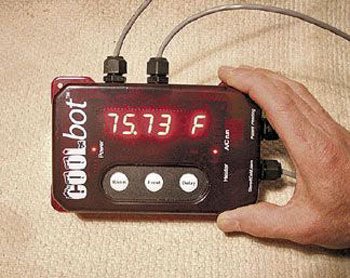
Meibao is the owner of One Goat Creamery in the foothills of the Sierra Nevada. The name pretty much sums it up because Meibao has one milk goat. From the milk of her one goat, T.T., she is able to make 9 – 10 pyramids, about 10 oz each, per week.


Background
For 23 years, Meibao had a bed and breakfast and owned and ran a Mexican restaurant in Taos, NM. She also sold her cheeses and vegetables at the Farmers Market. While in Taos, she told the story of how she came to own a goat in a talk she gave at Meibao Nee- Pecha Kucha Night Taos Volume 10 from pechakuchataos on Vimeo” target=”_blank”>Pecha Kucha Night:
In 2013, she moved to California to be closer to her children and grandchildren.

Meribao’s grandson, James, at 5 years old milking
Now, she has a ranch and an organic farm in a rural mountain village. She raises cattle, sheep, chickens, turkey, guinea fowls, guinea pigs, and of course, her one milk goat. She told us: the cattle, sheep and turkey are for meat, the chickens are for eggs, the guinea fowls are to keep the tick population down, and the guinea pigs are for fun.

These hair sheep are for meat
Her Goat
T.T. is a tame doe who comes into Meibao’s house on occasion, and loves her massages after milking. T.T. ranges freely over Meibao’s 220 acres of land. Her diet consists of pasture grass, acorns, oak, yerba buena, toyon, manzanita, and wild raspberry leaves, organic carrots, flax and sunflower seeds, organic goat pellets, and non-GMO alfalfa. Her milk is organic, sweet and rich in butter fat.


Meibao’s Land
In addition to the farm animals, Meibao raises her own vegetables.


She preserves, cans, and dehydrates her produce. She loves to make fermented foods, including kimchi, dill pickles, and sauerkraut.





Meibao’s Cheese
Meibao is currently making bloomy rind pyramids. She uses geotrichum and P. candidum molds on the outer rinds and a line of ash in the middle. They are aged for 7 days in the wine cooler, long enough for the white fluff to develop.
“This is such an important part of cheese making … the quality of milk one uses. I wish you stressed this more. Only use organic milk, whether it be cow, goat, or sheep … or why bother? My cheese is also raw, alive, and transforms with time from firm to a runny, full flavored, mildly sweet … sort of like aged Camembert used to be.”

“I use French maritime pine ash* in the middle for the pyramids, and in a Holiday Round that is filled with cherry tomato marmalade that I made from cherry tomatoes from the garden. They are both excellent cheeses.
*French maritime pine ash is an edible ash that was used in France on cheese to preserve the surface from unwanted bacteria and molds hundreds of years ago. It is alkaline, and gives the surface of the cheese a milder, sweeter taste, cutting some of the acid bite in bloomy rind cheeses. I also like how it give the cheese a distinctive decorative look to it, like a sumie painting.”

She told us: “I don’t tend to follow directions on making cheese. I salt my cheese after draining by mixing 2 tablespoons of sea salt into the curds and stirring it in. I also don’t flip the cheese back and forth at any time. I just put it in the molds, drain it overnight, turn molds upside down onto sushi mats and put them in the wine cooler ($159 from Costco) and let it sit there untouched for 7 days.
There’s no mold on the bottom. I fill the mold with 13.5 oz of salted curds. By the end of 7 days, I’ll get about 10.5 oz of aged cheese. It’s then wrapped and put into the fridge to age some more.”

She also makes a bloomy rind with no ash. She told us: “This one is heated to a higher degree then cooled, which creates a thick, creamy, luscious, buttery tang, like fine Camembert. At about weeks 4 and 5, it ages into a runny, stronger tasting cheese; its flavor becoming more complex, sweet, luscious, deeply creamy. The taste is reminiscent of true French cheeses made on small farms. It is a living food that transforms with time, getting better and better.”

In the past, she has made many other types of cheese:

She doesn’t remember the name of the cheese in front, only that it was delicious!

Aged bloomy rind raw goat with Herbs de Provence

Raw goat blue cheese

Another raw goat blue cheese

The large round is a raw goat milk tomme. Smaller rounds are bloomy rinds with and without lavender blossoms.

Lavender goat butter
Using Whey
Fermented Bread:
She uses whey instead of water to make fermented bread. If a recipe calls for 2 cups of water, she uses 2 cups of whey. It bumps up the protein in the bread and it makes the bread rise more after three days of fermentation.
There are two types of whey: whey that comes directly from draining the cheese and whey that come from draining ricotta, which is cooked. Both types of whey work well.
She mixes 4 cups organic hard winter wheat berries with 2 cups rye berries and mills that into a whole wheat flour. She uses an electric Wonder Mill. After milling, the flour is put into the freezer immediately to keep it from going rancid.

Meibao’s Recipe for Fermented Bread
This is a no-knead fermented bread, which takes 3 days to make.
Take out starter and warm on counter a couple hours.
1. Put 2 cups into large bowl, leave 1 cup in starter jar. In the large dough bowl with the 2 cups of starter, add:
2 cups organic unbleached flour
1 cup whole wheat flour
1.5 cups whey
Mix well, let it sit on counter until it starts to ferment and bubble. Then, put it in the refrigerator.
2. For Starter jar:
Add 2 cups whole wheat flour and 1+ cup of whey, mix well, leave out for a few hours, then put into fridge.
Mix well, let sit out on counter a few hours, then put into fridge overnight
3. Next day, take the large dough bowl out of fridge and let it sit a couple hours on counter. Then add:
3 cups organic unbleached flour
1/2 cup organic poppy seeds (optional)
1 cup plus 2 T whey
1 rounded T of Real salt into whey then stir vigorously until all the salt has dissolved.
Add the salted whey to dough and stir slowly to incorporate.
Leave out until it begins to rise…several hours, depending on how warm it is in the room.
Then put it in the fridge overnight.
4. Next day, around 9 a.m., take it out, let it sit on the counter several hours until the dough doubles in size. Gently fold sides with spatula into middle about 3 times.
Let it sit again until it doubles in size. (Room should be 75 degrees, 1.5 hrs)
Cut and weigh 2 pounds of dough, put onto parchment paper on flat tray.
Gently shape without handling dough very much.
Sprinkle flour on top and brush to evenly spread flour.
Let it rise again about 1 hour, again, depends if room is warm enough. (I use my dehydrator and set the temperature at 80 degrees for 1 hour.)
5. Put into cold oven, turn temperature to 450 degrees for 40 minutes. I use Wolfgang Puck’s Pressure Oven, which is great for baking bread.
(If using regular oven do this to get a crisp crust. Put a baking pan on lower shelf. Heat oven to 450. Before putting bread in, put a cup of cold water onto baking pan to create steam. Put in bread quickly, and close door. Bake for 30minutes or until done.)
The bread has a nice crust with a soft, elastic, chewy interior. It has a full rich flavor from the fresh milled flour, the whey, and the fermentation process … earthy
and deep.
The starter is the important ingredient and every starter is different, depending on the type of microbes that are floating about in your house. It takes a week to make a strong starter. I used only freshly milled whole wheat flour for the starter. It makes for a stronger bacteria. After you have a starter, you just have to add flour, whey and salt.
My starter is about a year old. I first used water and flour, then switched to whey and flour to feed the starter. I use the whey from making ricotta.

Gjetost:
Another thing Meibao uses whey for is gjetost, a Swedish cheese. She simmers the whey down until it’s a brown sludge (8 hrs or so). She then adds spices like cloves, cinnamon, chili, also, cream and sugar. It’s great on bread or eaten alone.
Meibao’s Philosophy of Food
“I only use ORGANIC … and this is the most important emphasis. Conventional flour is bromated to preserve it. Bromate is carcinogenic. This is what I found when I googled “why farmers spray RoundUp on wheat:”
Farmers often had trouble getting wheat and barley to dry evenly so they can start harvesting. So they came up with the idea to kill the crop (with glyphosate) one to two weeks before harvest to accelerate the drying down of the grain. The pre-harvest use of glyphosate allows farmers to harvest crops as much as two weeks earlier than they normally would, an advantage in northern, colder regions. The practice spread to wheat-growing areas of North America such as the upper Midwestern U.S. and Canadian provinces such as Saskatchewan and Manitoba. Glyphosate is a known hormone disruptor.
Check out article from www.mercola.com for more information on RoundUp and glyphosate.
People who are interested in making cheese and baking bread should know the dangers of using conventional milk and flour. This allows them make an intelligent choice. Having one milk goat does not cost very much to feed, and one is in control of what goes into the milk. I feed all my farm animals only organic food … and if I can’t afford it, then I have less animals. This keeps everything manageable.”














































































































































